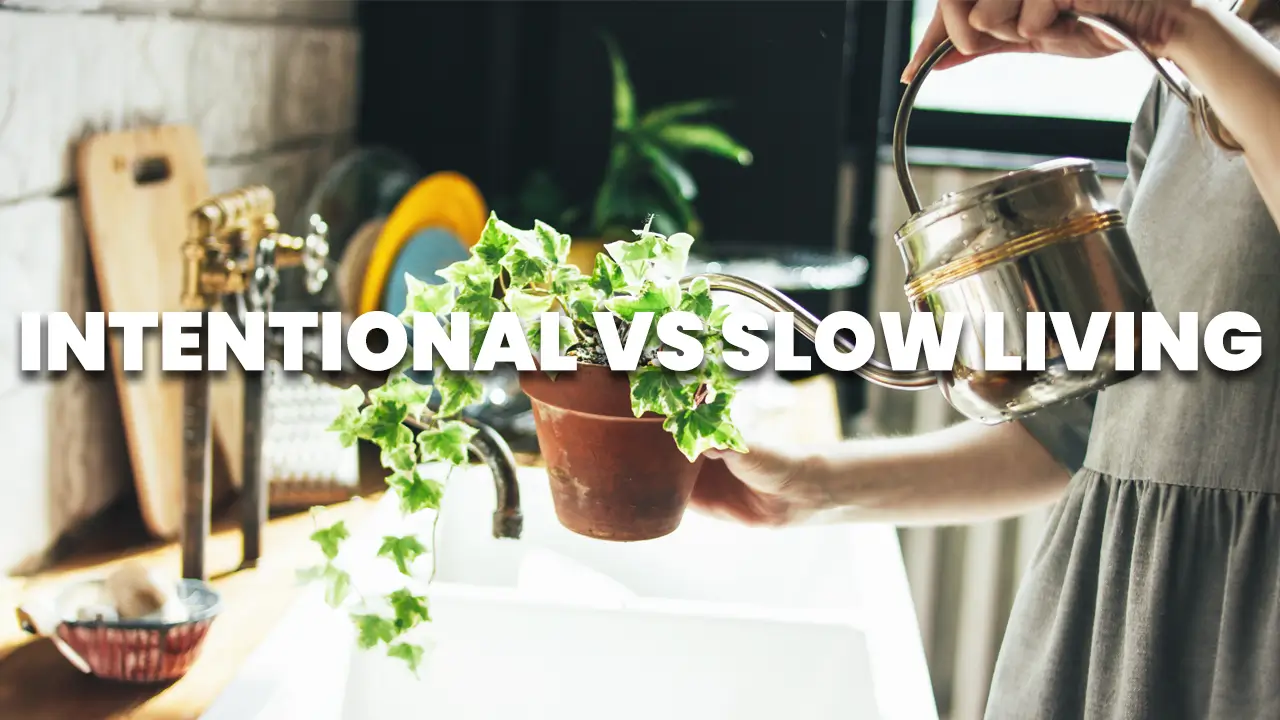What’s the Difference Between Intentional and Slow Living

Table of Contents
Summary of Difference between Intentional and Slow Living
| Intentional Living | Slow Living |
|---|---|
| Focuses on aligning actions with values and goals. | Emphasizes a slower pace and savoring the moment. |
| Can be practiced at any pace, as it’s more about the alignment of actions. | Specifically prioritizes reducing speed in life. |
| Broad in application, affecting all aspects of life from work to personal growth. | Often focuses on specific areas like consumption, leisure, and environmental sustainability. |
| Encourages making conscious choices and prioritizing activities that bring fulfillment. | Encourages disconnecting from technology and focusing on simplicity and experiences over possessions. |
Simple Examples of Each Lifestyle (Difference between Intentional and Slow Living)
| Intentional Living Examples | Slow Living Examples |
|---|---|
| Setting specific career goals that align with personal values. | Spending an entire afternoon reading a book without rush. |
| Decluttering your home to live with items that have meaning or purpose. | Cooking meals from scratch and enjoying the process. |
| Choosing hobbies and activities that contribute to personal growth and happiness. | Taking long walks in nature, observing and appreciating the surroundings. |
| Saying no to social commitments that don’t align with personal well-being. | Practicing mindfulness and meditation to connect deeply with the present moment. |
Introduction
In recent years, there has been a marked shift in societal values, steering away from the fast-paced, consumption-driven lifestyle to one that is more mindful and purposeful. This shift has given rise to two popular lifestyle movements: intentional living and slow living. Both philosophies advocate for a more deliberate approach to life, yet they are often misconstrued or used interchangeably, leading to confusion, as there is some slight difference between intentional and slow living.
Intentional living revolves around understanding and aligning one’s actions with personal values and goals, essentially living life on purpose rather than by default. It involves making choices that are deliberate and based on individual beliefs, leading to a more fulfilling and meaningful life. On the other hand, slow living emphasizes reducing speed, focusing on the present, and savoring life’s moments. It’s about quality over quantity, doing less, but more thoroughly and enjoying the simple pleasures of life.
Despite their similarities, there is difference between intentional and slow living as they have distinct characteristics and applications in daily life. This post aims to demystify these concepts by exploring their origins, philosophies, and how they manifest in everyday activities. We’ll delve into the benefits of each lifestyle, understand their unique strategies, and provide guidance on how you can incorporate elements of both into your daily routine. As we journey through the nuances of these movements, you’ll gain a clearer understanding of how they differ and, more importantly, how they can be harmoniously integrated for a more thoughtful and fulfilling way of life.
Defining Intentional Living
Aligning Actions with Values
The core principle of intentional living is about making choices that are in harmony with one’s deepest values, priorities, and sense of purpose. It’s about living a life that reflects who you are and what you believe in, rather than what society expects of you. This alignment leads to a more authentic and fulfilling life.
Key Characteristics
| Characteristics | Description |
|---|---|
| Mindfulness | Being fully present and engaged with the current moment, activity, or person. It means being aware of your thoughts and feelings without distraction or judgment. |
| Self-awareness | Understanding your own needs, desires, faults, and strengths. It’s about recognizing your patterns and how they align or misalign with your values. |
| Conscious Decision Making | Making choices deliberately, considering the long-term effects and how they align with your values and goals. |
| Prioritization | Focusing on activities and commitments that bring the most value and joy, and saying no to those that do not align with your priorities. |
Benefits of Intentional Living
Intentional living isn’t just a lofty ideal; it offers tangible benefits that significantly enhance the quality of life. Here are a few:
- Reduced Stress: By focusing on what truly matters, you alleviate the burden of trying to do everything, leading to lower stress levels.
- Increased Personal Satisfaction: Living intentionally means your actions are aligned with your beliefs, leading to greater personal fulfillment.
- A More Meaningful Life: By consciously choosing how you live, you create a life that is rich in meaning and purpose.
Examples of Intentional Living
- Setting Clear Goals: Define what success and happiness look like to you, not what others have told you they should be. Set goals that reflect your values and purpose.
- Saying No to Unnecessary Commitments: Practice saying no to tasks or activities that don’t align with your priorities or add value to your life. This frees up time for what truly matters.
- Decluttering Your Home and Life: Remove physical clutter as well as unnecessary activities and toxic relationships. This simplifies your life and focuses your energy on what’s truly important.
Trends and Innovations in Intentional Living
- Digital Minimalism: As technology becomes more pervasive, there’s a growing movement to intentionally reduce digital consumption, leading to more time for real-world interactions and less digital distraction.
- Eco-Conscious Choices: Increasingly, people are aligning their values with environmental sustainability, making intentional choices about consumption, waste, and transportation to reduce their ecological footprint.
- Community Living: There’s a resurgence in community-oriented living spaces where sharing resources and collective decision-making are practiced, reflecting a commitment to communal values and support systems.
Defining Slow Living
Now you will be able to understand the difference between intentional and slow living. Slow living is a lifestyle choice dedicated to stepping back from the hectic pace of modern life to enjoy a more measured, mindful, and sustainable way of living. It’s about finding joy in the slower moments and making conscious choices that align with a more deliberate, serene approach to life.
Embracing a Slower Pace
The core principle of slow living is the intentional reduction of speed in all aspects of one’s life. It’s about embracing the present moment, focusing on quality over quantity, and understanding that faster isn’t always better.
Key Characteristics
| Characteristics | Description |
|---|---|
| Mindfulness | Engaging fully with the present moment and task at hand. Slow living encourages a heightened state of awareness and presence. |
| Appreciation for Simplicity | Finding joy and satisfaction in the simple aspects of life, reducing the need for excess and overconsumption. |
| Disconnecting from Technology | Intentionally limiting the use of digital devices to decrease stress and increase quality of life. |
| Focusing on Experiences Over Possessions | Prioritizing meaningful experiences and personal growth over the acquisition of material goods. |
Benefits of Slow Living
Slow living offers numerous benefits that contribute to a more serene and contented life. These include:
- Reduced Stress: Slowing down helps in managing and reducing stress levels by avoiding the culture of constant urgency.
- Increased Awareness: By taking the time to slow down, individuals become more mindful of their surroundings, thoughts, and feelings, leading to greater self-awareness.
- Deeper Connection with Self and Others: Slow living allows for more meaningful interactions and relationships by providing the time and space to nurture them.
Examples of Slow Living
- Cooking Meals from Scratch: Taking the time to prepare meals with care and attention, enjoying the process as well as the result.
- Spending Time in Nature: Engaging with the natural world at a leisurely pace, whether it’s gardening, hiking, or simply sitting outdoors.
- Taking Mindful Walks: Walking slowly and attentively, observing the surroundings with each step, and using the opportunity to reflect or meditate.
- Prioritizing Personal Connections: Choosing quality time with loved ones over other distractions, focusing on deep, meaningful interactions.
Innovations and Less-Known Aspects of Slow Living
- Slow Travel: Instead of rushing from one tourist destination to another, slow travelers take their time to immerse themselves in the local culture, often staying in one place for longer periods.
- Slow Fashion: Embracing sustainability in clothing choices, supporting ethical brands, and prioritizing quality and longevity over fast-changing trends.
- Mindful Consumption: A growing awareness of the environmental and social impact of our purchases has led to more people choosing to buy less and choose well, focusing on the sustainability and ethics behind products.
Comparing and Contrasting the Difference between Intentional and Slow Living
Intentional living and slow living are closely related philosophies that share many common principles, yet they also have distinct differences that set them apart. Understanding these similarities and differences can help individuals decide which aspects of each philosophy they might want to incorporate into their own lives.
Similarities
Both intentional living and slow living emphasize:
- Mindfulness: Being present and fully engaged in the current activity.
- Prioritization: Focusing on what truly matters and letting go of the rest.
- Living with Purpose: Each philosophy encourages individuals to live according to their own values and beliefs.
Differences
Here you can see the difference between intentional and slow living in multiple aspects:
| Aspect | Intentional Living | Slow Living |
|---|---|---|
| Pace | Can be practiced at any pace; more about the alignment of actions with values, regardless of speed. | Emphasizes a slower pace of life, taking time to savor each moment and experience. |
| Focus | Prioritizes aligning one’s life with personal values and long-term goals. | Prioritizes the present moment, focusing on experiencing life deeply rather than on outcomes. |
| Application | Broad and flexible, can be applied to all aspects of life including work, relationships, health, and personal growth. | Often focuses on specific areas such as consumption, leisure, and environmental sustainability. |
Recent Trends in Living Philosophies
While traditional aspects of difference between intentional and slow living are well known, here are a few newer angles that are gaining traction:
- Integration with Technology: While traditionally both lifestyles might eschew much of modern technology, there’s a growing trend to use it mindfully to enhance and enable the difference between intentional and slow living practices, such as apps for meditation and digital detoxes.
- Slow Cities Movement: Beyond personal lifestyle, entire communities are adopting slow living principles, aiming to improve the quality of life for all residents by slowing down the overall pace of life.
- Intentional Work Environments: Not just limited to personal life, intentional living is being integrated into how people approach their work, with a focus on meaningful and value-aligned careers over simply working for a paycheck.
Finding Your Balance
Incorporating elements of difference between intentional and slow living into your life isn’t about strictly adhering to one philosophy or the other. It’s about creating a lifestyle that resonates with your personal needs and circumstances, blending aspects of each to cultivate a life that feels authentic and fulfilling.
Tailoring Your Approach
- Reflect on Your Values and Goals: Understand what matters most to you and let that guide your blend of the difference between intentional and slow living.
- Assess Your Current Lifestyle: Identify areas of your life that feel rushed or misaligned with your values and consider how slowing down or being more intentional could benefit those areas.
- Experiment and Adjust: Try incorporating different practices from both philosophies and observe how they impact your life. Keep what works and modify or discard what doesn’t.
Examples of Combining the Two
- Intentional Nature Time: Set a specific goal to spend time in nature each week, such as a quiet walk in the park or a day spent hiking, to disconnect from the rush and reconnect with the world around you.
- Mindful Consumption: Make intentional choices about the products you buy, aiming for quality over quantity and considering the environmental impact, aligning with both the mindfulness of slow living and the value-alignment of intentional living.
- Tech-Free Evenings: Designate certain evenings as technology-free, using the time to engage in slow activities like reading, crafting, or spending quality time with loved ones.
Conclusion
In this article, we looked at the difference between intentional and slow living. Intentional living is all about making choices that match your personal values and goals. It’s like having a map for your life and following it. Slow living, on the other hand, is about taking your time to enjoy life and not rushing through it. It’s like enjoying a slow, peaceful walk instead of running.
Understanding the difference between intentional and slow living can help you figure out what works best for you. Maybe you want to plan your life carefully, or perhaps you prefer to take it slow and enjoy each moment. Or, you might mix a bit of both in your life. As you think about these styles, you might also want to look into other ideas like living simply or taking breaks from technology. Remember, the way you live your life is up to you, and these ideas are just options to consider.
Share your thoughts or experiences with intentional and slow living, what is the difference between intentional and slow living from your perspective. What practices have you adopted? What benefits have you noticed? Your insights could inspire and guide others in their journey towards a more intentional and slower-paced life.



